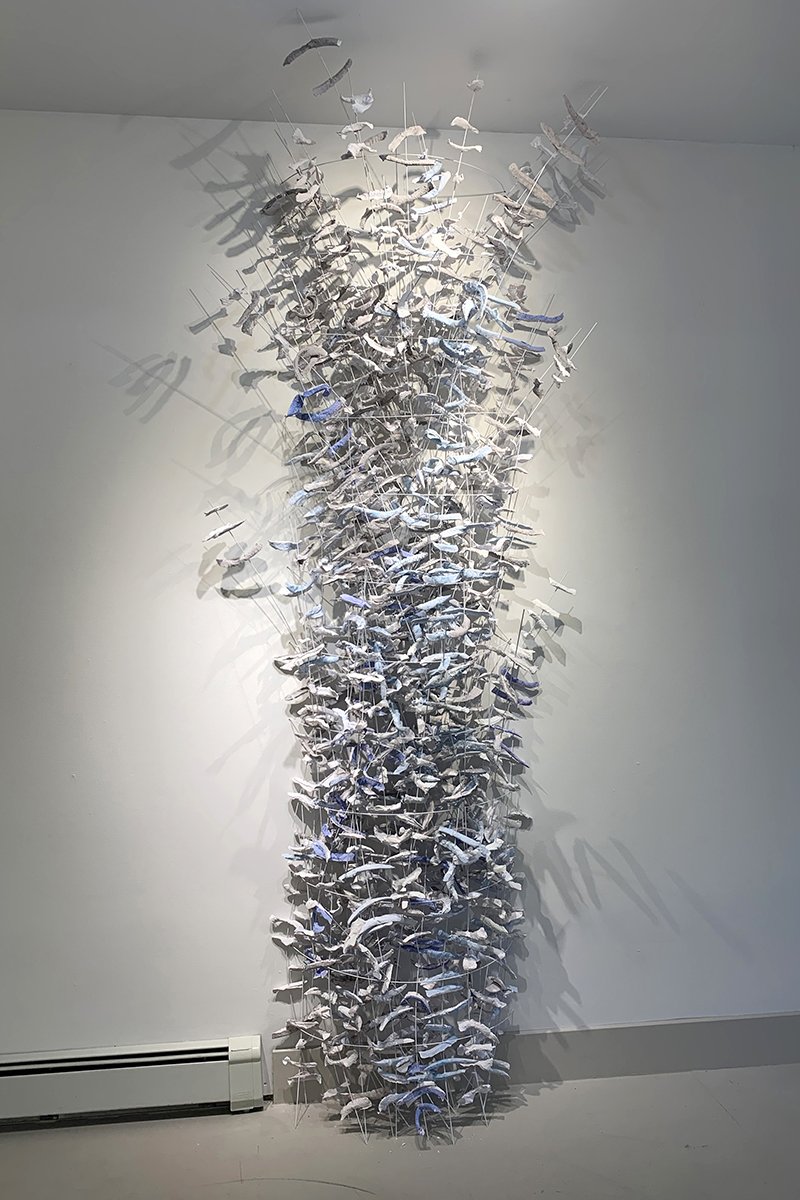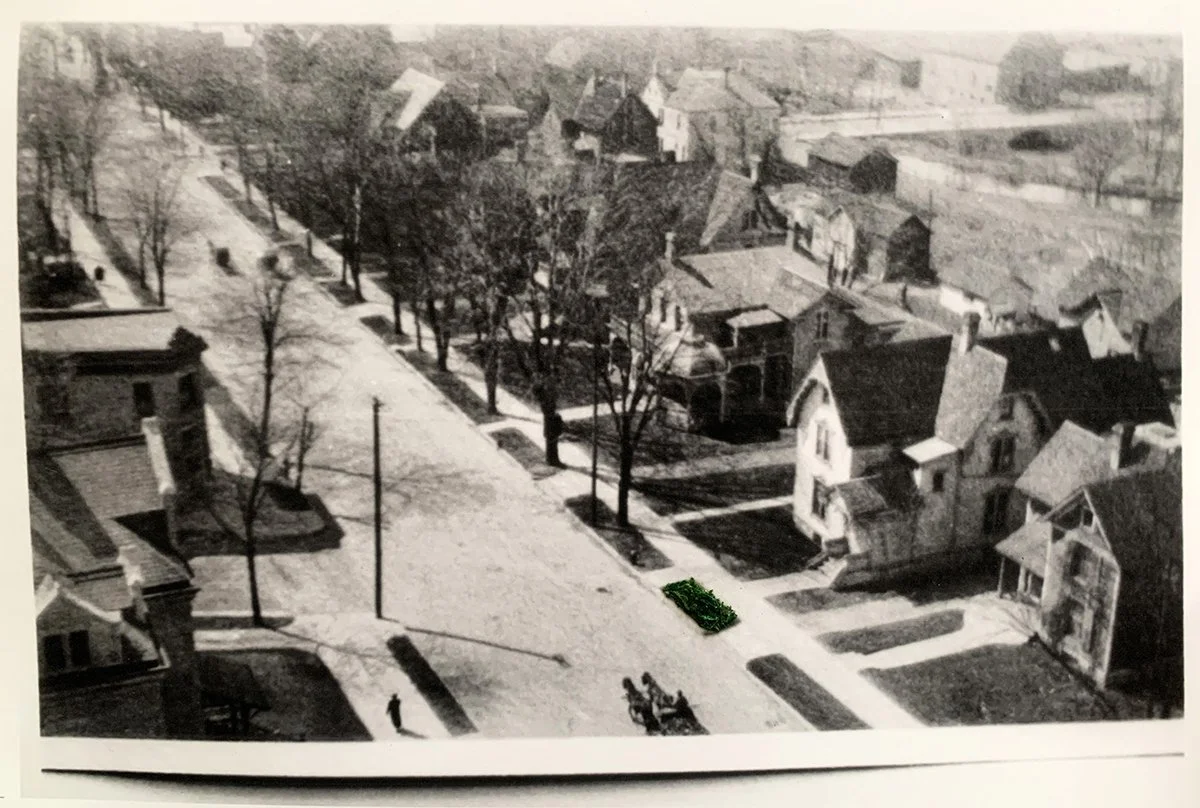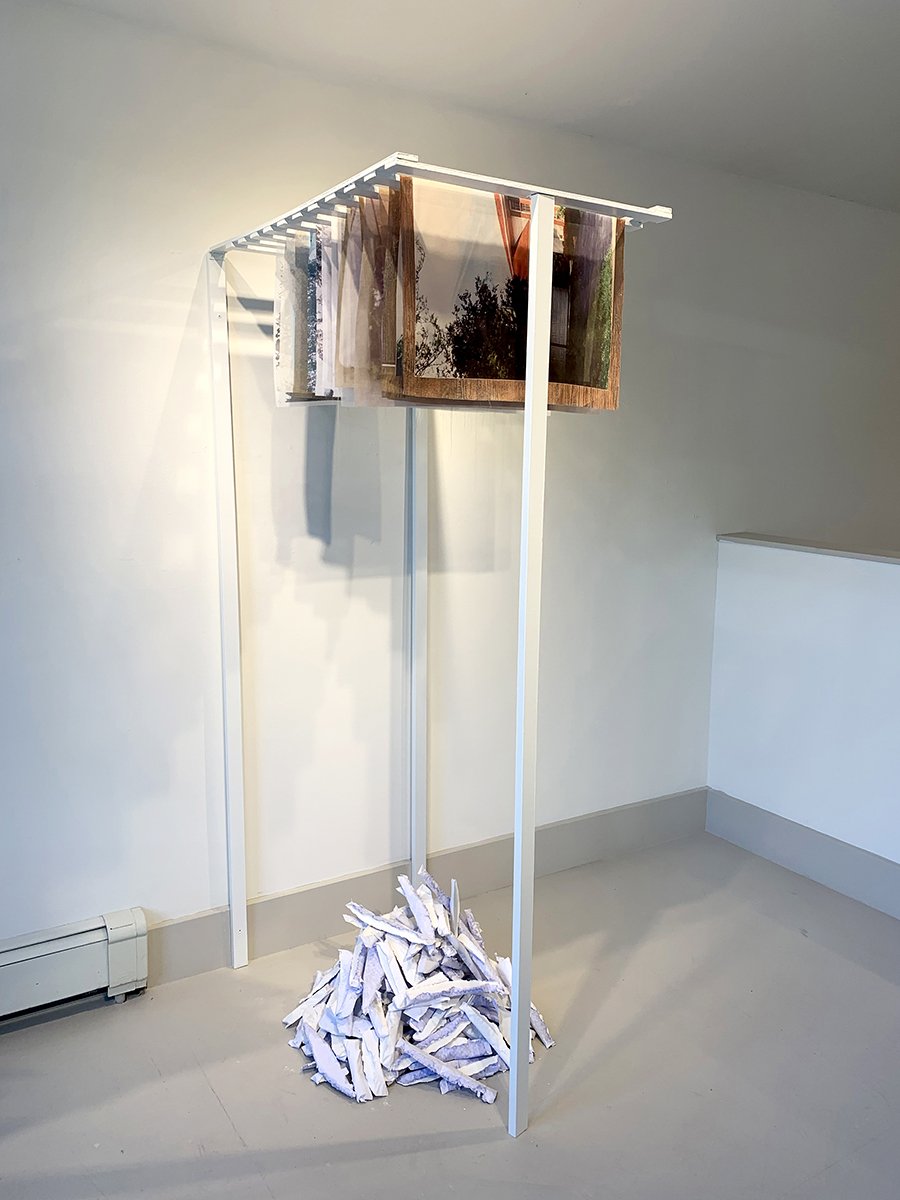Stephanie Land
White Flight, 2022. Alginate, brass rods, acrylic paint, envelope remains. 132 x 48 x 12 inches
ARTIST STATEMENT
Working as a multi-disciplinary artist in sculpture, photography, installation; and with artist books, textiles and the archives, my practice considers and investigates the social, cultural, and political, with a particular attention to race, gender and power. As a white woman, my work as an artist is rooted in understanding the historical and cultural context of my family and self, in order to open up conversations and break through generational white silence.
As a baseline I use the intimate relationship between architecture and nature to define how space is built, how we function within it and in turn, how it provides safety or provokes precarity in public and private. Through explorations with various materials, I use repetition to understand the subject and the evolution of each piece, with deliberate and thoughtful considerations
Interview with Stephanie Land
Main Street, 2022. Mixed media, including archival pigment print with moss. 11 x 17 inches
Can you tell us a bit about your background and how you became interested in becoming an artist?
I grew up in a creative family, my dad is a musician and my mom has always had a talent in crafts and sewing. My parents put me and my brother in a lot of creative outlets as kids and teens, for me - flute and piano, dancing - but when I took my first photography darkroom class in high school, everything changed. I dropped everything and knew I wanted to study photography.
Can you tell us about some of your most memorable early influences?
It was mostly books, music and music videos. Being a teen in the late 80’s to mid 90’s, I was heavily influenced by music and visually influenced by MTV and VH1. Music videos told stories that I wasn’t seeing in the white suburbs of Chicago. They made me want to see the world. I’ve always been a voracious reader and Maya Angelou’s I Know Why the Caged Bird Sings left a permanent impression on me, so much so that when I read it in high school I painted a quote from the book on my bedroom wall “To be left alone on the tightrope of youthful unknowing is to experience the excruciating beauty of full freedom and the threat of eternal indecision.” We didn’t go to museums as a kid but all of the stories from books and music left a lasting creative impression.
Where are you currently based and what brought you there? Are there any aspects of this specific location or community that have inspired your work?
I’m based in Brooklyn, I moved here from Chicago in 2006. NYC has completely influenced my life and art. I originally came with dreams of being a color darkroom printer or a photographer for FADER— so specific I know! At the time I was doing much more street photography and environmental portraiture, solely with film and polaroid. Being able to walk outside and find inspiration at every turn and encounter people from all over the world is truly an abundant life.
What is your studio space like? What makes your space unique to you?
My studio space is in the basement off our duplex. For me, it’s a space of refuge, wonder, curiosity, play, deep thinking and frustration - all the things that come with being an artist. I love surrounding myself with imagery, books and objects. My studio goes in waves of every surface being covered to over-organized. Last summer my studio space extended out to the front porch where I planted a bunch of different potted flowers. Tending to them was an extension of working with my hands and suddenly I became a person who loves sitting on the porch smiling at my flowers. But that intentionality later made it into my art, and I’ve been incorporating nature, and casting flowers in hydrocal for my current project.
Homesteads, 1878 - 1998, 2022. Mixed media, including wood, paint, fabric, hydrocal, and envelope remains. 72 x 20 x 36 inches
What is a typical day like? If you don't have a typical day, what is an ideal day? Do you work in large chunks of time, or throughout the day?
I work in large chunks of time, mostly on the weekends, or in short spurts in the evening. It takes me a bit to get into it, so the large chunks of time are the most helpful - where I can really get in a groove - and then the smaller moments hold their importance in different ways. Sometimes it’s just checking in on the work, looking at what I’ve been working on, sitting with it for a few minutes and that feels like something. Staying consistent is the most important element to me. A lot of my pieces take time, they move slow, so it requires patience.
What gets you in a creative groove or flow? Is there anything that interrupts your creative energy?
I usually start my time in the studio listening to an interview, or artists in conversation. Sometimes, I’ll listen to a non fiction audiobook as research for some of the work. I watch a lot of Art21 on PBS. Lately I’ve been watching Tate and V&A Museum’s videos on artists. It’s a great entry point and they always lead me down an interesting path, inspiring my mood in the studio for the day.
I try to keep my phone at a distance while I’m in the studio since calls, texts and social media interrupt my creative energy. I used to have a hard rule about it but now that I’m not on Instagram, I’m not as tempted to get sucked down a rabbit hole for big chunks of time.
How do you maintain momentum in your practice? Is there anything that hinders or helps your focus?
Momentum is a far more intimidating word than consistency for me. Momentum is quite difficult to maintain given life’s challenges, and for me, it sets an expectation that feels unattainable. I didn’t know I would have such a reaction to that word! In one way or another, I’m always thinking about my practice, the pieces I’m working on, or dreaming of the things I’d love to do with the work. Living with it and living creatively provides that throughline. I have many elements that help keep me healthy mentally: meditating, running or biking, playing the flute, laughing with my friends, and seeing art. We’re always absorbing our life experiences. Everything we do is a part of the work.
Sundown Town, 2021. Archival digital print. 52 x 31 inches
What medium/media are you working in right now? What draws you to this particular material or method?
I’m currently working with hydrocal, which is somewhat new to me in the past two years. I was working with alginate for a long time and now I’m discovering the detail that hydrocal can pick up in casting - it’s incredible. I’m also playing with watercolor markers in my drawing practice. Drawing is completely new to me so it feels like an ongoing discovery of line, shape, shading and blending. A different way to zone in.
Can you walk us through your overall process in making your current work? Does drawing play a role in your process?
My practice is research based and the research weaves in and out of the making. A lot of time elements of the archive appear in the final pieces. Photography influenced my use of the multiple, working from a negative. Repetition is important for me to think through, both for form and for the piece as a whole. My process has evolved over the years, but I’m more open to letting the piece guide change, and shift my ideas, than I used to be.
Drawing is a completely new part of my practice, I’m not yet sure how it will play into the process. We’ll see!
What is exciting about your process currently?
I have more trust in myself and my work these days. The sense of urgency that came from external pressures feels released and now if I’m feeling urgent it’s solely based on the ideas or inspiration wanting to get out.
Can you talk about some of the ongoing interests, imagery, and concepts that have informed your process and body of work over time? How do you anticipate your work progressing in the future?
I’ve long been interested in race, gender and power as a through line. Understanding the history of this country in a more intersectional way is deeply important to me. I listen to a lot of conversations on race, reparations, land back movements. I’m also interested in the relationship between architecture and nature - how our built spaces reflect or reject our natural spaces and the feelings that come from moving through both.
White : Silence, 2019. Mixed media, inclduing alginate and copper wire. 168 x 96 x 12 inches
Do you pursue any collaborations, projects, or careers in addition to your studio practice? If so, can you tell us more about those projects, and are there connections between your studio practice and these endeavors?
I’ve been a Creative Producer within the fields of design, media and architecture for over a decade. I’m currently a Sr Integrated Producer at G&A, an exhibition design studio. Working on interdisciplinary teams, my role leading multiple project logistics, it has informed ways I organize my studio projects, my time and more. There’s a lot that I’m able to utilize in my art practice.
Have you had any epiphanies recently that have changed the course of your work or caused you to shift directions?
An ongoing epiphany is the realization I can make whatever I want, in whatever form, and it will always be truthful because it’s coming from me. It’s simultaneously the most intimidating thing and the most freeing thing about being an artist - there are no rules, there is no one recipe for success or fulfillment. Again, intimidating but exciting. I’m incredibly grateful to live this life as an artist - how lucky are we?!
Can you share some of your recent influences? Are there specific works—from visual art, literature, film, or music — that are important to you?
Ah, so many influences! I have been reading a lot about Ruth Asawa recently. After finally seeing her sculptures in person, they have stuck with me. I recently saw her drawing show at the Whitney and was enamored. I love seeing dance, it influences me in a different way than visual art does. I constantly have music playing - right now I’m listening to douniah, Cleo Sol, Fabiano do Nascimento, Yuseef Days, L’Rain and so many more. Literature this year has been a deep dive back into fiction and what a joy it has been! Some of the novels I read this year are How to Not Drown in a Glass of Water by Angie Cruz, Hangman by Maya Binyam, The Last White Man by Mohsin Hameed and Ours by Phillip B. Williams. Get your order in for Ours (Feb 2024, Viking) - it’s one of the most beautiful novels I’ve ever read! A couple of non fiction books recently read were Ordinary Notes by Christina Sharpe and White Sight: The Visual Politics and Practices of Whiteness by Nicholas Mirzoeff, My wife’s writing The Black Period and Un-American by Hafizah Augustus Geter), research and thinking is a consistent influence - she is truly one of the most brilliant thinkers of our time.
Can you elaborate on a recent work of yours, and tell us the story of how it came to be?
White Flight was an important piece for me. As part of the Negatives Preserved series, I traveled to Waukesha, Wisconsin to research my great-great-grandfather who was a photographer in the late 1800’s. I worked with the Waukesha Historical Society and photographed around the city while retracing my family’s steps. The piece started small, unsure of how the shape would play out. Revisiting an idea from years before that I never acted on, I brought in the form of the silo, a form that stands out to me as one of the symbols of the Midwest. Until I saw it completed in my solo show at DVAA (Delaware Valley Artists Alliance), I hadn’t built it to that scale. Like many of my other pieces it’s held together mostly by itself with just the thin pieces of brass pinning it against the wall. White Flight is the largest piece I’ve made to date.
Tending To, 2017. Mixed media, including alginate, copper leaf, pine, and paint. 48 x 72 x 4 inches
Have you overcome any memorable roadblocks or struggles in your practice that you could share with us?
I think it’s an underlying difficulty to continue making work - the hope and imagination is always there for each year, for each piece, each application and potential opportunity. But it’s a part of the practice to imagine and put yourself out there so it has been something I’ve made more peace with in my mid 40’s. The pace of my accolades ultimately will not impact the pace of my work, slow and steady. I will be making work regardless of the outcome because it’s something I have to do to feel whole and happy.
Who are some contemporary artists you’re excited about? Is there a recent exhibition that stood out to you?
Kapwani Kiwanga’s Off Grid at New Museum, Tomashi Jackson’s, The Land Claim book, Pamela Council’s A Fountain for Survivors, Daniel Ramos’ show Eres Muy Hermosa at Baxter Street, Shilpa Gupta’s Listening Air piece at Tanya Bonakdar, Maia Cruz Palileo’s Long Kwento book, Ozioma Onuzulike’s show at Marc Straus. I can go on and on - the beauty of living in NYC is stepping out to see this work in person, take it all in and process it on the train ride back home.
Do you have any tips or advice that someone has shared with you that you have found particularly helpful?
Being surrounded by many writers and poets, one of the most valuable things I’ve learned from them is, the more specific you are - getting to the detail of the specificity - the more universal the work becomes. I never learned that in all of my art education - the goal in those spaces felt like to make broad strokes it would be more relatable. When the reality is, if the viewer can absorb the most minute detail of an experience, they can connect on a deeper level. It’s taken me many years to understand this and get closer to it.
Stephanie Land
What are you working on in the studio right now? What’s coming up next for you?
I’m still planning for the next phase of my series, White,, which engages with my familial archive. The next phase will be in Buffalo, NY and Norway - working with local archives. I have a lot of ideas about how I’ll extend the project. I’m also in the midst of a new body of work about the last phase of healing. After living with PTSD from a traumatic experience in my teens, it’s taken me 25 years to feel ready to make work about it and speak about it. I’m casting with hydrocal and working with plants, branches, flowers. I’m not sure of the outcome yet but it feels good and right. In the new year I’m taking a botanical drawing class with NYBG and very excited about that. Infinite curiosities!
Anything else you would like to share?
Thank you so much for the feature and thank you to Stephanie Baptist, Medium Tings!
To find out more about Stephanie Land check out her website.







